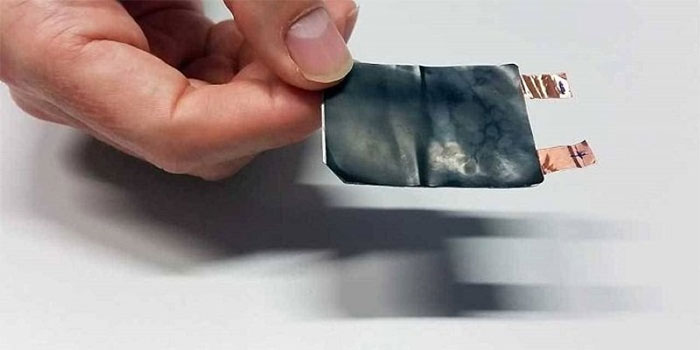Successfully developed a stretchy, fabric-soft battery
Dr. Nguyen Ngoc Tan (University of British Columbia) and his colleagues have for the first time successfully fabricated a stretchable, fabric-soft battery for use in smart sensors.
Batteries used for smart sensors are a popular technology trend today. For example, in the biomedical field, there are applications that require the patient to wear a smart shirt for about 10-12 hours a day, including when going to sleep.

Batteries can be as soft as an invented garment.
If using a normal battery, it will certainly cause problems and be very uncomfortable for the wearer. "Without soft and safe batteries in contact with the human body, it will be difficult to continue to develop sensor-based clothing," said Dr. Tan.
Working at the Advanced Materials and Process Design Laboratory, from 2019, Dr. Tan started to survey and found that the field of flexible batteries has also had a lot of research, but the actual product is almost not. Yes. More importantly, 'how to make the battery last a long time (for example, a few years) and be safe enough to wear on people, or even wash it in a washing machine, no one has seen it yet', Dr. Tan said. know.
The key to the technology is the battery cover material. The material must meet the need to prevent gas and liquid exchange to minimize the movement of molecules from the inside out and from the outside of the battery; Has a low modulus of elasticity to accommodate integration into stretchy electronics;
Be compatible with battery components as well as biocompatible (no harm to the body), especially in applications that seamlessly integrate the device and the human body; Ease of fabrication, especially being able to use existing manufacturing processes; Has mechanical and chemical strength over the lifetime, even when deformed during washing.
To solve the problem of body compatibility, Dr. Tan's research team selected zinc and manganese dioxide - substances that are safer than the components of conventional lithium-ion batteries - as materials to participate in the reaction. A chemical reaction that produces an electric current.
But the key issue and also the most difficult point in this research is how to make the material have the ability to prevent water from penetrating the battery, and at the same time adhere to the different layers of the battery. If the battery has very good adhesion between the layers, then when it is pulled or washed in hot and cold temperatures in the washing machine, the layers will move together and withstand those impacts.
The team decided to choose a polymer - a readily available material that has been used in medicine but has never been used in battery research before. When experimenting with polymers, Dr Tan's research team found that the material not only had high chemical stability and biocompatibility, but was also the least water-permeable of any elastomeric material. when.
After more than a year of tinkering, testing as well as building a new manufacturing process (because this type of battery is completely different from normal batteries), TS Tan's research team has developed a new type of battery consisting of many layers of super thin, containing a mixture of crushed zinc and manganese dioxide (for stretching), and bonded with the same polymer.
When tested in a washing machine, the results showed that the battery developed by TS Tan's team could 'survive' through 39 washes and still function well. 'It can be seen that, with this structure, the battery is not waterproof and still ensures its integrity over many uses,' the team shared.
To further test the battery's endurance, Dr. Nguyen Ngoc Tan's research team tested it with both cold and hot washing modes (up to 80°C), each wash lasting about 1.5 hours. clock. Test results show that the battery is still resistant and works fine after washing.
After the success of this research, Dr. Tan said that his research team has closely linked with a number of companies that are pursuing smart clothing products to test batteries to assess their ability to meet demand. actual demand. Currently, the battery researched by Dr. Tan's team has a voltage of about 1.5V - lower than the 3V voltage of lithium-ion batteries due to the balance between capacity and safety issues.
- New invention: 'big' clothes with children
- Intelligent fabric can detect and protect against harmful gases
- Successfully developed a 10 millisecond response stretch thermometer
- The first fish swimming fast, swimming like fish
- Will have a 'soft charger' technology to help protect the battery
- Waterproof fabric thanks to its ability to drain water
- Successfully manufactured high performance sodium-ion battery
- The invention of a new battery contains five times more energy than a lithium-ion battery
- Inventing a 10-year battery does not require charging
- India successfully developed the world's first iron-ion battery
- He developed a sensor cloth that tracks body movement
- Japanese fabric color change by temperature
 'Barefoot engineer' invents a pipeless pump
'Barefoot engineer' invents a pipeless pump Process of handling dead pigs due to disease
Process of handling dead pigs due to disease Radiometer
Radiometer Warp Engine: Technology brings us closer to the speed of light
Warp Engine: Technology brings us closer to the speed of light